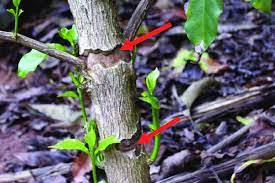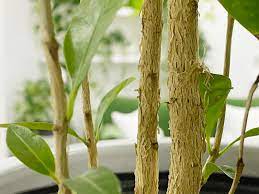Coffee stems refer to the woody, structural parts of the coffee plant that support the leaves, flowers, and coffee cherries. These stems are an essential component of the coffee plant’s overall structure and play a crucial role in its growth and development.
Coffee stems are typically brown to grayish in color and become more lignified (hardened) as the plant matures. They emerge from the main trunk of the coffee plant and extend upwards, branching out into smaller stems that hold the leaves and, eventually, the coffee cherries. These stems transport water, nutrients, and sugars throughout the plant, facilitating growth, photosynthesis, and fruit production.
The coffee stems are an important factor in determining the overall health and productivity of the coffee plant. Pruning and maintenance of the stems are common agricultural practices to ensure optimal growth conditions, efficient nutrient distribution, and good airflow within the coffee plantation. Well-maintained stems can also contribute to a more organized and manageable coffee canopy, making it easier to harvest the coffee cherries.
Coffee stems are the structural elements of the coffee plant that support its growth and play a vital role in the production of leaves and coffee cherries. Proper care and management of these stems are crucial for maintaining healthy and productive coffee plants.
The Economic Importance and Uses of Coffee Stems

Coffee stems, though not as commonly highlighted as coffee beans, also have some economic importance and uses.
Here are some of them:
1. Mulch and Compost: Coffee stems can be used as a source of organic matter for creating mulch and compost. When ground up and added to compost piles, they contribute to nutrient-rich soil amendments that enhance soil structure, water retention, and nutrient content.
2. Soil Erosion Control: Coffee stems can be used as erosion control materials in agriculture. Placing the stems on slopes or areas prone to erosion helps prevent soil loss and improves soil stability.
3. Biofuel Production: Coffee stems can be converted into biomass for biofuel production. Biomass energy can be harnessed through processes like gasification or direct combustion, contributing to renewable energy sources and reducing reliance on fossil fuels.
4. Craft and Art Projects: In some cases, coffee stems are used for artistic and craft purposes. They can be woven into baskets, sculptures, and other decorative items, providing opportunities for local artisans and creative projects.
5. Livestock Bedding: Coffee stems can be used as bedding for livestock, particularly for small animals like rabbits or guinea pigs. They provide a comfortable and relatively absorbent material for animal cages.
Read Also: Sugarcane Roots: Economic Importance, Uses and By-Products
6. Mushroom Cultivation: Coffee stems, especially those left over from coffee production, can serve as a substrate for cultivating certain types of mushrooms. This offers an additional source of income for farmers and promotes sustainable agricultural practices.
7. Natural Fencing and Barriers: In some regions, coffee stems are used to create natural barriers, fences, or borders. They can be arranged to mark property boundaries or protect crops from animals.
8. Biodegradable Packing Material: Coffee stems could potentially be processed into biodegradable packing materials. As the demand for eco-friendly packaging increases, exploring alternative materials like coffee stems could contribute to reducing plastic waste.
9. Biocontrol and Pest Management: Some studies suggest that certain compounds found in coffee stems may have insecticidal or repellent properties. These properties could be harnessed for biocontrol and integrated pest management strategies in agriculture.
10. Carbon Sequestration: Left in the field after coffee harvest, the stems can contribute to soil carbon sequestration, which helps combat climate change by reducing atmospheric carbon dioxide levels.
The Products and By-products That Can Be Derived From Coffee Stems

Coffee stems, like many plant materials, can be utilized for various purposes to reduce waste and maximize their potential.
Here is a list of potential products and by-products that can be derived from coffee stems:
1. Biomass for Energy Production: Coffee stems can be used as a source of biomass for energy generation through processes like combustion, gasification, or biofuel production. The cellulose and lignin present in the stems can be converted into heat, electricity, or biofuels.
2. Animal Feed: Coffee stems can be processed and used as supplementary feed for livestock, especially ruminants. While they are not as nutritious as other feed sources, they can still contribute to the animals’ diet.
3. Compost: Coffee stems can be composted along with other organic materials to create nutrient-rich compost that can be used to improve soil fertility and structure.
4. Mulch: Chopped or shredded coffee stems can be used as mulch to cover the soil surface around plants. Mulching helps retain soil moisture, suppress weed growth, and regulate soil temperature.
5. Crafts and Art: Coffee stems can be dried, dyed, and used in crafts and art projects. They can be woven into baskets, used for decorative purposes, or even turned into sculptures.
Read Also: 8 Medicinal Health Benefits of Saussurea obvallata (Brahma Kamal)
6. Natural Fiber Production: Coffee stems can be processed to extract fibers that can be used in the production of textiles, ropes, or other fiber-based products.
7. Paper and Cardboard: The cellulose content of coffee stems can be used in the paper and cardboard industry to produce eco-friendly materials.
8. Biodegradable Packaging: Coffee stems can potentially be used as a source for producing biodegradable packaging materials, reducing the environmental impact of traditional plastics.
9. Medicinal and Nutraceutical Products: Some compounds present in coffee stems might have potential health benefits. Research could explore their use in herbal medicine or nutraceutical products.
10. Soil Erosion Control: Coffee stems can be used in erosion control efforts, such as creating barriers or stabilizing slopes to prevent soil erosion.
11. Biochemical Extraction: Coffee stems could be a source of various bioactive compounds, which can be extracted and used in industries such as pharmaceuticals, cosmetics, or food additives.
12. Biochar Production: Coffee stems can be used to produce biochar, a type of charcoal used for soil amendment to improve soil structure and nutrient retention.
In conclusion, it is important to note that the utilization of coffee stems for these purposes might require appropriate processing and treatment to ensure the desired quality and safety of the derived products. Additionally, the feasibility and practicality of these applications can vary based on factors such as local availability, technology, and market demand.
Read Also: Waste Management Jobs – Tips to Get Started
